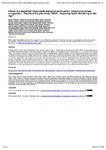Effects of a sequential mixed-mode design on participation, contact and sample composition – Results of the pilot study “IMOA – Improving Health Monitoring in Old Age”
Gaertner, Beate
Lüdtke, Denise
Koschollek, Carmen
Grube, Maike M.
Baumert, Jens
Scheidt-Nave, Christa
Gößwald, Antje
Fuchs, Judith
Wetzstein, Matthias
Existing health survey data of individuals who are 65+ years of age is limited due to the exclusion of the oldest old and physically or cognitively impaired individuals. This study aimed to assess the effects of a sequential mixed-mode design on (1) contact and response rates, (2) sample composition and (3) non-response bias. A register-based random sample of 2,000 individuals 65+ years was initially contacted by mail to answer a health questionnaire. Random subgroups of initial non-responders were further contacted by telephone or home visits. Participation by interview or proxy was possible. After postal contact only, the initial contact and response rates were 51.7% and 37.8%, respectively. The contact and response rates increased to 71.1% and 44.6%, respectively, after all contact steps. A different sample composition regarding sociodemographic (i.e., older individuals) and health characteristics (i.e., worse self-rated health, more functional impairments) was achieved by the inclusion of those late participants. Ill health was the second most frequent reason for non-participation. Personal contact modes are important to increase contact and response rates in population-based health studies and to include hard-to-reach groups such as the oldest or physically impaired individuals. However, non-response bias still occurred.
Dateien zu dieser Publikation

